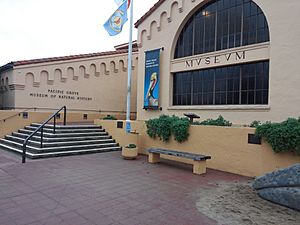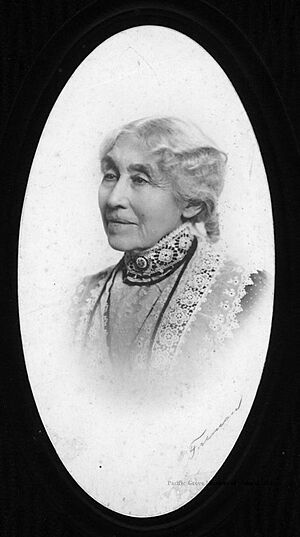Pacific Grove Museum of Natural History facts for kids

Exterior of the museum
|
|
| Established | 1883 |
|---|---|
| Location | 165 Forest Avenue Pacific Grove, California |
| Type | Natural history museum |
The Pacific Grove Museum of Natural History is a cool museum in Pacific Grove, California. It's close to the Monterey Bay Aquarium. This museum is like a living guide to the California Central Coast. It shows off local plants, animals, rocks, and the history of people who lived there.
The museum first opened in 1883. It was one of the first natural history museums in America. Important naturalists like John Muir helped start a tradition of learning about nature by doing hands-on science. The museum is officially recognized by the American Alliance of Museums.
Contents
Discover the Central Coast: Museum Exhibits
The museum's exhibits are like a field guide to the California Central Coast. You can learn about birds, other wildlife, plants, geology, and the rich history of local cultures. The museum really highlights what makes this part of California special.
Meet Sandy the Gray Whale
When you visit, you'll be greeted by "Sandy." Sandy is a life-size sculpture of an adult female gray whale. Artist Larry Foster designed and created her. The community helped raise money to buy Sandy in 1982. She is dedicated to the children of Monterey County.
Amazing Birds of Monterey County
The museum has a collection of over 400 bird specimens from Monterey County, California. You can see local birds like the California condor. There are also many other important bird specimens on display.
Monarch Butterflies: Life Cycle and Migration
Pacific Grove is the biggest public spot where monarch butterflies spend the winter in Monterey County. From Thanksgiving to Valentine's Day, these butterflies gather in the Monarch Grove Sanctuary. The museum has an exhibit about the monarch's migration and their life cycle. Volunteers from the museum also help visitors see the monarchs at the sanctuary. They offer viewing scopes and explain what you're seeing.
Native Plants in the Museum's Backyard
The museum's backyard is home to over 100 plant species native to Monterey County. These plants are grouped into five different natural areas. These include coastal scrub, chaparral, mixed oak woodlands, butterfly host and nectar plants, and ethnobotany (how people use plants).
Fun Events at the Museum
The museum hosts several exciting events throughout the year.
Annual Wildflower Show
The museum's Annual Wildflower Show happens on the third weekend of April. This show displays more than 700 different wildflower species from Monterey County. It's the largest wildflower show in the Northern and Western Hemispheres! The museum started this show in 1962 with the California Native Plant Society.
Illustrating Nature Exhibition
The museum's annual Illustrating Nature exhibition is held in May. This show features amazing artwork from students graduating from CSUMB Extended Education's Science Illustration Program.
Learning and Education Programs
The museum offers science and cultural education programs for the California Central Coast. They serve schools and families in Monterey, Santa Cruz, San Benito, and Stanislaus counties.
- Science Saturdays: These are free, hands-on activities about culture, science, and art. They happen on the last Saturday of each month, except June, July, and December. The themes change every month.
- Class Field Trips: Schools can take free field trips to the museum. These trips are very popular and help students learn while having fun. All museum lessons match the Next Generation Science Standards for PreK-5th grade.
- Monarch Grove Sanctuary Class Field Trips: During the monarch overwintering season, museum volunteers offer free field trips to the Monarch Grove Sanctuary for PreK-5th grade classes.
- Class Outreach Programs: If schools can't visit the museum, an educator can come to them! A museum educator travels to the school and teaches a program to PreK-5th grade classes. These programs are made to fit the teacher's needs and cover topics from the Next Generation Science Standards. Topics include gems, minerals, Native Americans, life cycles, and mammals.
Community Science Projects
The museum is a hub for many community science programs. These programs let people of all ages help real scientists with their research.
- LiMPETS: This stands for Long-term Monitoring Program and Experiential Training for Students. LiMPETS gives middle and high school students, teachers, and the community hands-on experience monitoring the coast. They get to do real field research and become ocean protectors.
- Western Monarch Count: The museum works with the Xerces Society to track the population of the threatened Western Monarch Butterfly. The museum also tracks the monarch population weekly at the Monarch Sanctuary. This program runs from October to March.
- Black Oystercatcher Monitoring: In partnership with others, this program tracks the success of the Black oystercatcher, a local shorebird. This bird is an indicator species for rocky shore habitats. By studying it, scientists can understand how the whole ecosystem is doing.
- MPA Watch: This program monitors how people use the marine protected areas around the Monterey Peninsula. It works with WILDCOAST.
- Watershed Guardians: This program is for middle, high, and college students. They study the health of local Monterey County watersheds, like the Carmel River. They collect and record real-time water quality data.
Museum History
The museum has a long and interesting history!
Early Beginnings: The Chautauqua Museum
In June 1879, the Chautauqua Literary and Scientific Circle started its Pacific Coast branch in Pacific Grove. Every summer, they held a two-week event with lessons, exhibits, lectures, and concerts. Over time, members wanted a place to store and show the natural items they collected. In 1883, a small wooden octagonal building became the first home of the Chautauqua Museum. It was located in what is now Jewell Park.
Since Chautauqua was like a college, its teachers and students collected many specimens. They brought them to the museum to be shown. The first important collections included shells, sea mosses, and plants. As Pacific Grove grew, so did these collections.
Becoming the Pacific Grove Museum Association
By 1899, the museum needed its own organization. Miss Mary E. B. Norton helped a lot with this. In July 1900, Chautauqua gave the museum building and its 2,100 specimens to the new organization. This group became the Pacific Grove Museum Association in November 1900.
The association worked hard to improve the museum. They offered free winter lectures to members and held a spring exhibition of natural history and local art. A newspaper in June 1901 said it was a great success!
A New Home and Growth
In 1902, the Pacific Improvement Company gave the association the land where the modern museum now stands. The buildings already there were made into one larger building. The original octagonal building was even moved across the street to join it! This gave the association plenty of space for studying, working, and storing items. They also had outdoor space for native plants.
By 1904, the museum started getting animal specimens. In 1909, about eighty people were members. However, the museum didn't have much money. It relied on small membership fees, a few donations, and selling some plants. Many specimens were even sold to San Francisco after the big 1906 earthquake. Finally, in 1917, the City of Pacific Grove took over supporting the museum.
A Generous Gift and a Modern Museum
Dr. Ann Lukens donated $5,000 to the museum. But the biggest donation came from Mrs. Lucy Chase, a Pacific Grove citizen. In 1932, a new museum building was built on its current site for $14,000. Most of this money was donated by Mrs. Chase. The building opened to the public on December 21, 1932, which was her ninetieth birthday.
In 1933, some items that were not strictly natural history were removed. The goal was to focus only on natural history. In 1935, the American Association of Museums called the museum the "best of its size in the United States." In 1967, the Pacific Grove Museum Association became the Pacific Grove Museum of Natural History Association. It is now also connected with the Point Pinos Lighthouse and the Monarch Grove Sanctuary.
Images for kids



